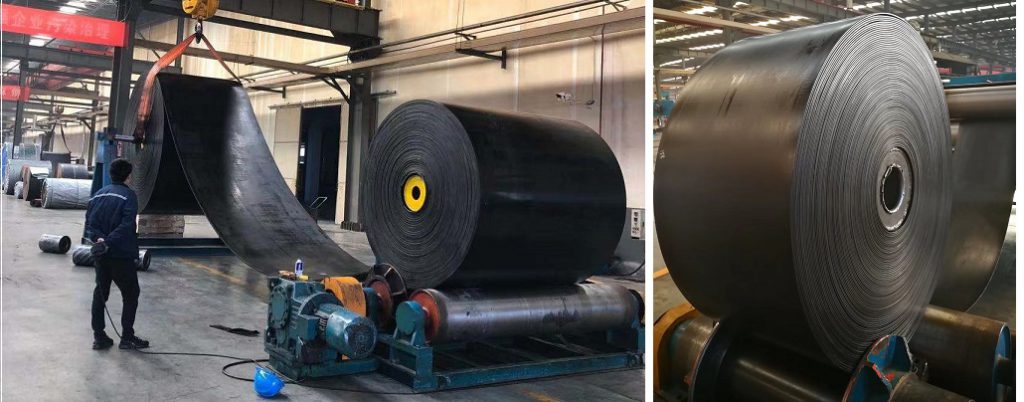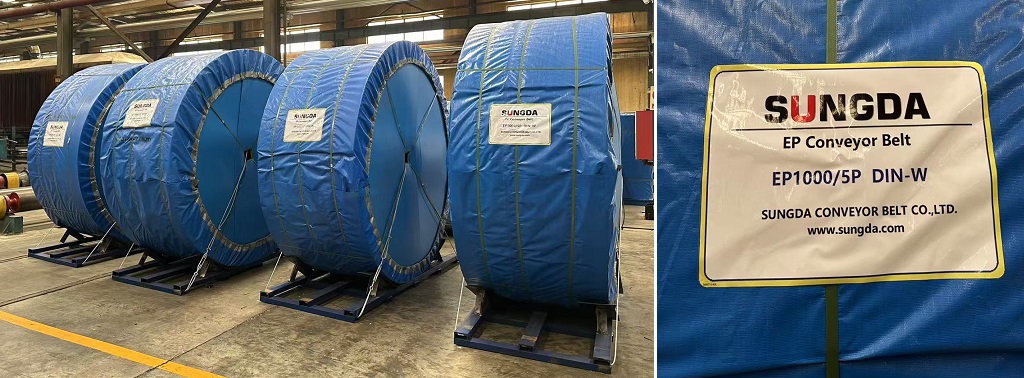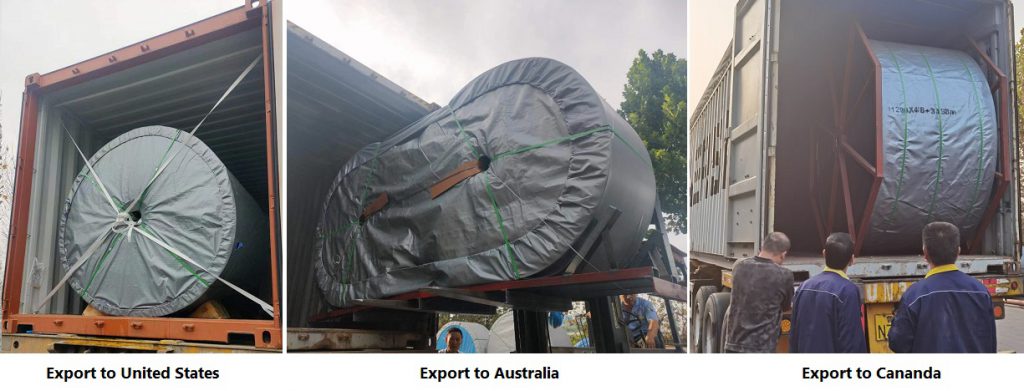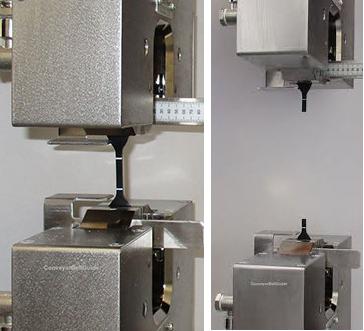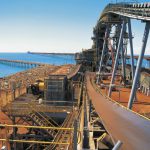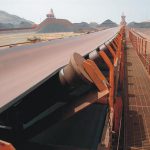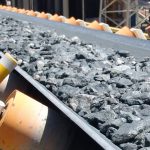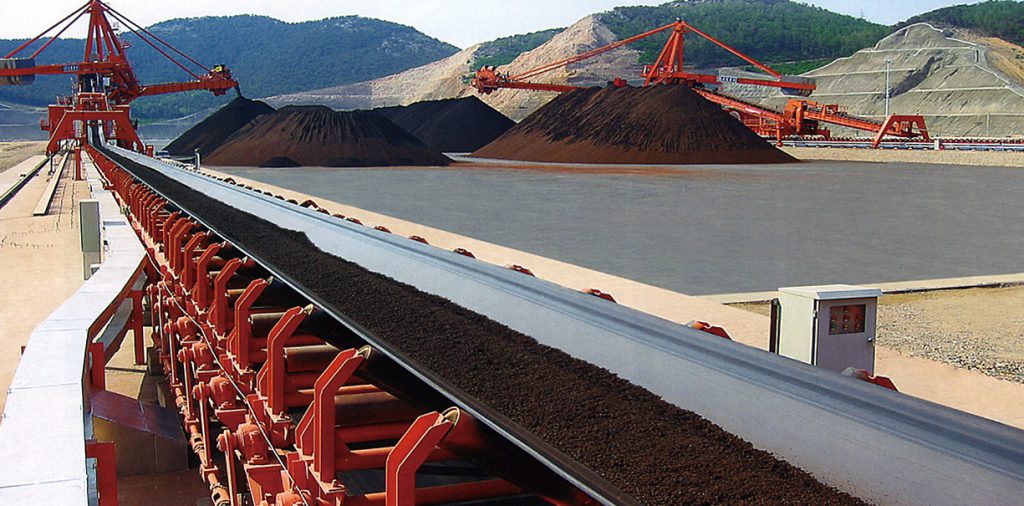How to Choose Right EP Conveyor Belt –SUNGDA Group
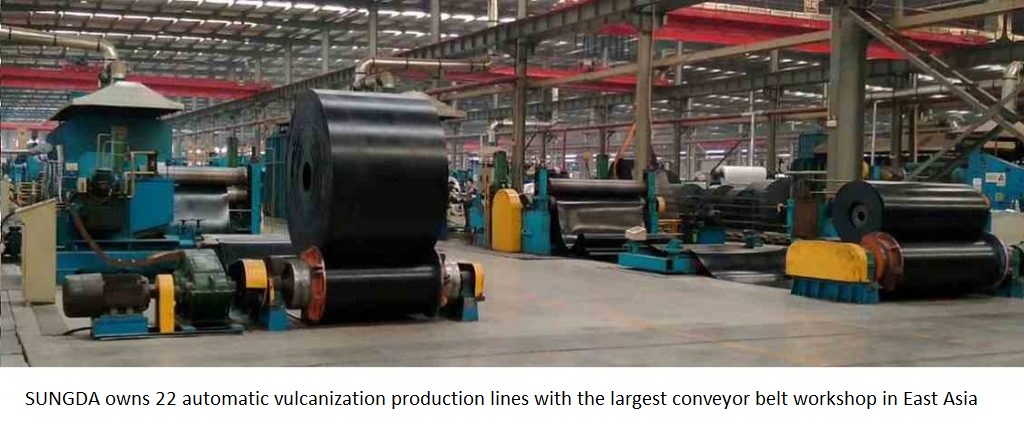
Polyester conveyor belt, also known as EP conveyor belt, is composed of multiple layers of polyester fabric bonded together as the carcass material, the EP conveyor belt has small elongation, impact resistance, soft belt body, light weight, good troughability, excellent elasticity, suitable for medium and long distance, high conveying capacity work and high speed conveying materials, it is used to transport bulk materials in coal, mining, cement plant, crushing plant,seaport, metallurgy, power station, chemical industry and other fields.

In such a complex environment, it is very important to choose the right conveyor belt, how to choose the conveyor belt with the highest working efficiency at the best economic cost?
1. Choose according to the length of the belt conveyor line
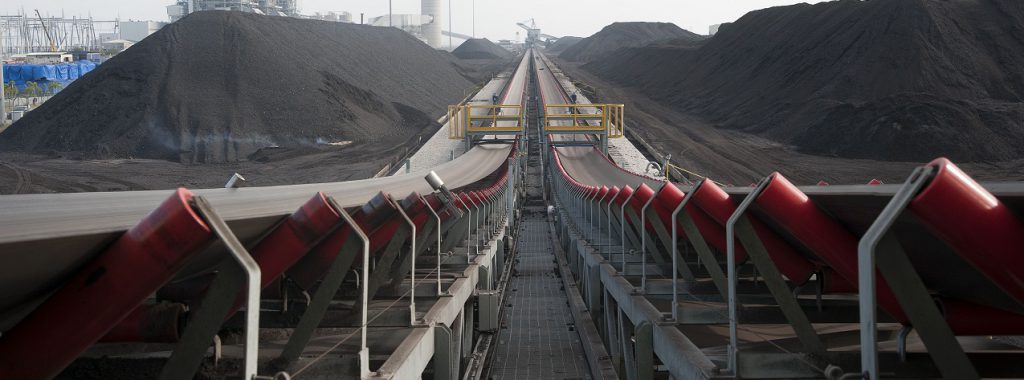
When choosing the type of EP conveyor belt, we should carefully study the relationship between the conveying volume, conveying distance, conveying speed and conveyor belt width.
The width of the EP conveyor belt must meet the requirements of conveying volume, conveying material granularity and tension, the maximum cross-sectional area “S” on the conveyor belt corresponding to various belt width is shown in Chart 1-1.
The value in the chart is the calculated conveying capacity Iv (m3/s) when the belt speed V=1.0m/s and the inclination coefficient K=1, the width of the EP conveyor belt can be determined according to the cross-sectional area.
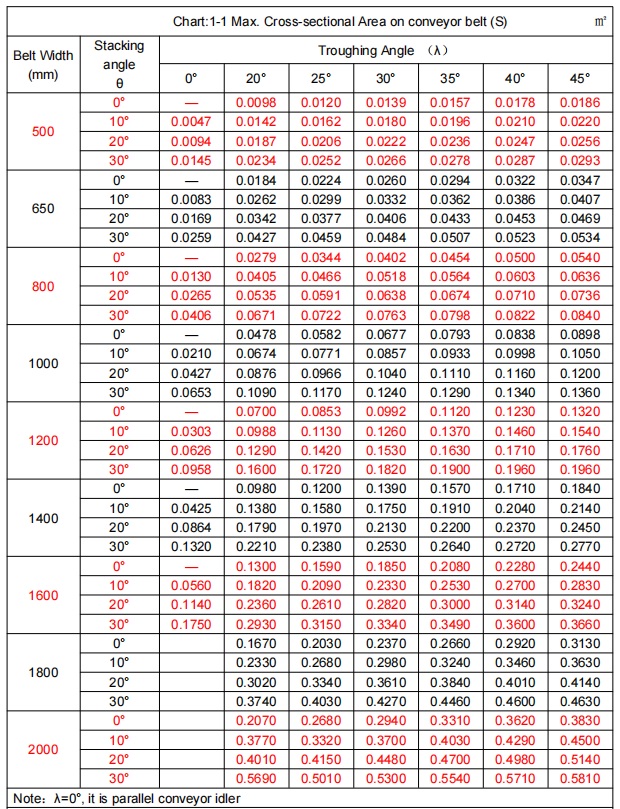
If the conveyed material contains large and hard block materials, and the direct drop at the receiving point is large, in addition to choosing the thickness and performance of the covering layer, the impact resistance of the conveyor belt should also be considered, conveyor belts with impact resistance and ripstop steel cord mesh should be used.
See chart 1-2 for the particle size of conveyed materials applicable to various EP conveyor widths.

The Top 5 Rubber Conveyor Belt Manufactures In China 2021
How to choose crushing plant conveyor belt for 100 ~ 1000T/H
scale?
EP conveyor belt layer is the more the better?
How to choose the cover thickness of conveyor belt?
2. According to the safety factor of the EP conveyor belt.
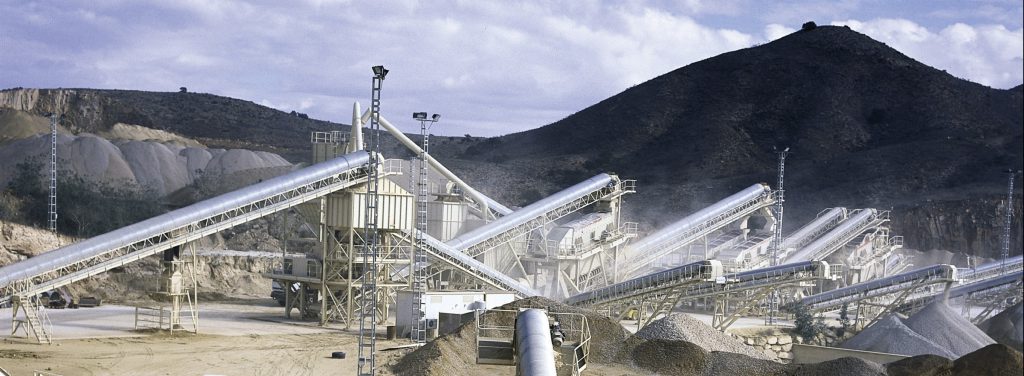
Reasonably determine the safety factor, and economically and reasonably select the EP model and the number of carcass layers of the EP conveyor belt.
The safety factor of the EP conveyor belt should consider factors such as safety, reliability, life, manufacturing quality, economic cost, splicing efficiency, starting factor, site conditions, use experience and other factors. When using it, it should be selected according to the experience of each manufacturer’s manual. For nylon (nylon) and polyester (EP) fabric carcass conveyor belts, the safety factor of vulcanized splicing is n=10-12; when the use conditions are severe and special safety is required, the safety factor should be greater than 12; the safety factor of mechanical splicing should be greater than 15.

3. The using condition of EP conveyor belt

To choose a EP conveyor belt, it must be adapted to the characteristics of the application, for special conditions, conveyor belts with special properties should be used.
The working environment temperature suitable for ordinary EP rubber conveyor belt is generally -10℃~40℃, when the working environment temperature is lower than -10℃, EP conveyor belt should not be used; when the working environment temperature is lower than -20℃, when the steel cord conveyor belt is adopted, the cold resistance requirement should be put forward to the manufacturer.
Ordinary EP rubber conveyor belts are suitable for conveying materials whose temperature does not exceed 80°C, when the temperature of conveying materials is between 80 and 150°C, heat-resistant EP conveyeor belts should be used (T1 type 100°C, T2 type 125°C, T3 type 150°C, T4 Type 180℃); when the temperature of the conveying material is 300~500℃, you should consult the manufacturer for a higher-grade heat-resistant conveyor belt; when conveying materials with acidic, alkaline, corrosive, oily substances and organic solvents, Rubber conveyor belts with acid and alkali resistance, corrosion resistance and oil resistance should be used. Flame-resistant conveyor belts should be used for conveyor belts that work in places with fire hazards or in underground coal mining and other workplaces that emit combustible dust.
4. The coordination of the cover rubber and the belt carcass

The coordination of the cover rubber and the belt carcass of the EP conveyor belt should be considered when selecting the model. The specific parameters are as follows:
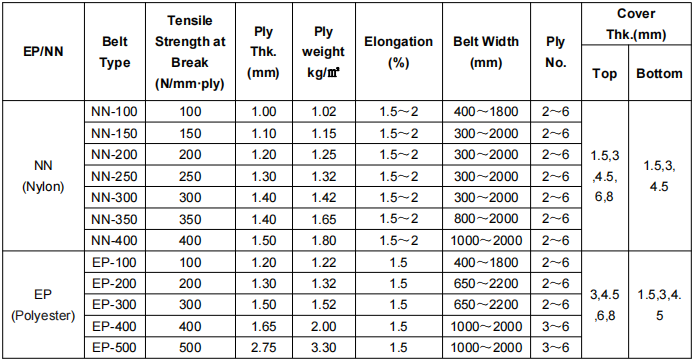
The quality of EP rubber conveyor belts is often reflected in its adhesive properties, this index will directly affect the service life of the conveyor belt, the adhesion includes the adhesion between the EP fabric layer and the adhesion between the fabric layer and the cover glue, if the adhesion is good, it will be beneficial to EP The effect of the anti-aging and heat resistance of the conveyor belt, the ideal adhesive strength is generally 3.5N / mm between the fabric layers and 3.2N / mm between the fabric layer and the cover layer.
At present, the conveyor belt manufacturers improve the adhesion performance the method is to use high-quality rubber as the cover rubber matrix of the EP conveyor belt, and then mix it with different chemical formulas to give it a good covering layer aging performance. This method is also the most effective, because high-quality rubber is highly saturated and can be used normally in a 150-degree working environment, and its adhesion will not have to worry.
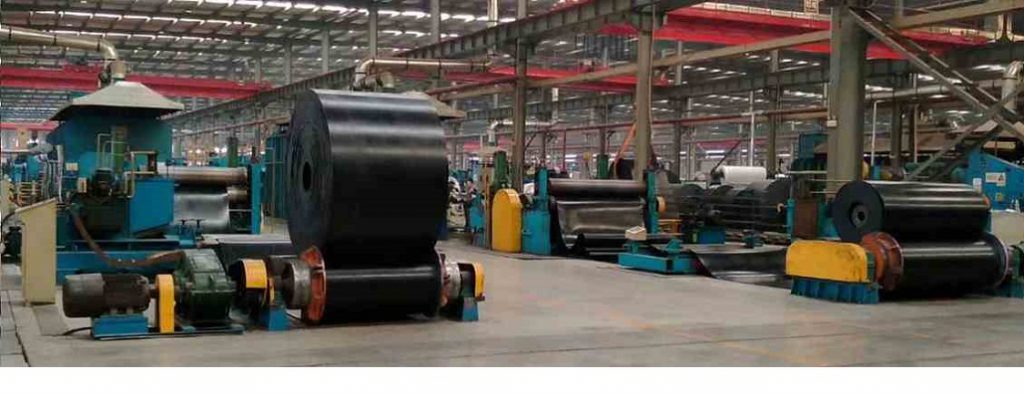
The selection of EP fabric for conveyor belt is also very important, EP fabric has better performance in cold and heat resistance, and has better tortuosity and tear resistance, generally speaking, EP fabric has four choices of tensile models: existing EP100, EP150, EP200, EP250, EP300, EP350, EP400, the EP150 is used more often to meet the basic required tensile force, the EP200 is next, the EP400 is generally used for long-distance and heavy-weight transportation.
Different grades of conveyor belts need corresponding EP fabrics, for example, heat-resistant conveyor belts need to choose HMLS (high mold low shrinking) EP fabric, so the deformation of the EP fabric will be small under high temperature environment.
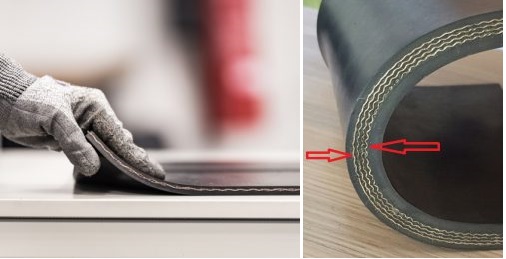
When choosing the number of layers of EP fabric, it is not that the more layers, the better, if there are too many layers, the conveyor belt will cause excessive squeezing between the fabric layers when passing through the surface of the roller, which will affect the fabric layer and the cover layer, the adhesion between them causes stress and can cause the risk of the fabric layer falling off, generally speaking, the ep fabric layer is a safer choice in the 3-5 layer.
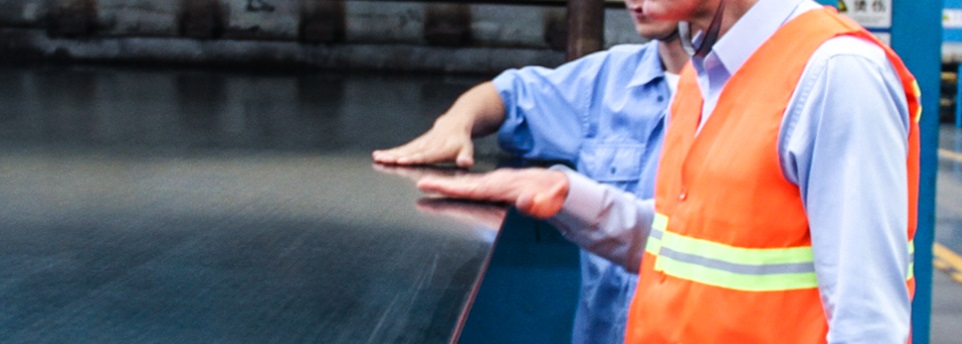
The rubber cover of EP rubber conveyor belt must have a certain tensile strength, if the tensile strength is high, the degree of deformation generated when the conveyor belt transports materials is small, if the weight of the material carried on the conveyor belt is too heavy or the use interval is too small, the conveyor belt will become loose and soft, which will affect the use.
The general conveyor belt will have 15Mpa (DIN-Z), 18Mpa (DIN-W), 20Mpa (DIN-Y) and 25Mpa (DIN-X), of which 15Mpa and 18Mpa can meet most of the transport strength requirements, in addition the conveyor belt itself density is also important. Everyone knows whether a material is strong and durable is mainly determined by its own density, the conveyor belt with high density is naturally very strong, and can be used for a longer time after purchase, therefore, although the rubber conveyor belt with poor performance will be cheaper in price, it needs to be replaced frequently, so it is more expensive than the conveyor belt with good performance.
SUNGDA Cover Rubber Grade for General Purpose:
DIN22102 Standard:

AS-RMA Standard:
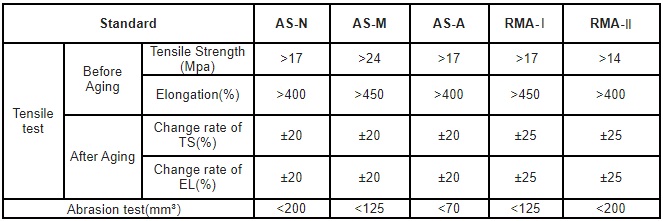
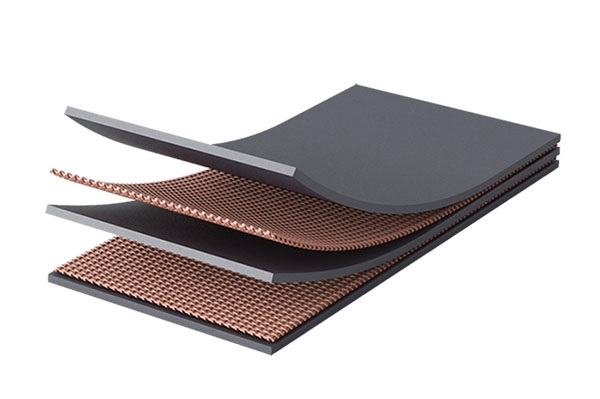
Muti-ply EP Fabric Grade (Tensile Strength kg/cm, PIW):
| Carcass | No. of ply | Tensile strength (kgf/cm) | Tensile at break (kgf/cm) | PIW |
| EP160/2 | 2 | 16 | 160 | 89.6 |
| EP200/2 | 2 | 20 | 200 | 112.0 |
| EP250/2 | 2 | 25 | 250 | 14.0 |
| EP315/2 | 2 | 31.5 | 315 | 176.4 |
| EP400/2 | 2 | 40 | 400 | 224.0 |
| EP400/3 | 3 | 40 | 400 | 224.0 |
| EP500/2 | 2 | 50 | 500 | 280.0 |
| EP500/3 | 3 | 50 | 500 | 280.0 |
| EP630/2 | 2 | 63 | 630 | 352.8 |
| EP630/3 | 3 | 63 | 630 | 352.8 |
| EP630/4 | 4 | 63 | 630 | 352.8 |
| EP800/3 | 3 | 80 | 800 | 448.0 |
| EP800/4 | 4 | 80 | 800 | 448.0 |
| EP1000/3 | 3 | 100 | 1000 | 560.0 |
| EP1000/5 | 5 | 100 | 1000 | 560.0 |
| EP1250/3 | 3 | 125 | 1250 | 700.0 |
| EP1250/4 | 4 | 125 | 1250 | 700.0 |
| EP1250/6 | 6 | 125 | 1250 | 700.0 |
| EP1600/4 | 4 | 160 | 1600 | 896.0 |
| EP1600/5 | 5 | 160 | 1600 | 896.0 |
The following table is currently the main internationally popular conveyor belt implementation standards:
| Cover Grade | Country | Applicable Standards | Min.Tensile Strength(Mpa) | Min.Elongation at Break(%) | Max.Abrasion Loss(mm3) |
| DIN-Z | Germany | DIN22102 | 15 | 350 | 250 |
| DIN-Y | Germany | DIN22102 | 20 | 400 | 150 |
| DIN-X | Germany | DIN22102 | 25 | 450 | 120 |
| DIN-W | Germany | DIN22102 | 18 | 400 | 90 |
| RMA-I | U.S.A | RMA | 17 | 400 | 150 |
| RMA-II | U.S.A | RMA | 14 | 400 | 200 |
| ARPM RMA-I | U.S.A | ARPM | 17 | 400 | 125 |
| ARPM RMA-II | U.S.A | ARPM | 14 | 400 | 175 |
| ISO-L | International | ISO -10247 | 15 | 350 | 200 |
| ISO-H | International | ISO -10247 | 24 | 450 | 120 |
| ISO-D | International | ISO -10247 | 18 | 400 | 100 |
| AS-N | Australian | AS -1332 | 17 | 400 | 200 |
| AS-M | Australian | AS -1332 | 24 | 450 | 125 |
| AS-A | Australian | AS -1332 | 17 | 400 | 70 |
| SANS-N | South Africa | SANS-1173 | 17 | 400 | 150 |
| SANS-M | South Africa | SANS-1173 | 25 | 450 | 120 |
| SANS-A | South Africa | SANS-1173 | 18 | 400 | 70 |
| BS-M | UK | BS-490 | 24 | 450 | 120 |
| BS-N | UK | BS-490 | 17 | 400 | 200 |
| IS-N-17 | India | IS 1891 | 17 | 400 | 200 |
| IS-M-24 | India | IS 1891 | 24 | 450 | 150 |
| JIS-G | Japan | JIS-K 6332 | 14 | 400 | 250 |
| JIS-L | Japan | JIS-K 6332 | 15 | 350 | 200 |
| JIS-D | Japan | JIS-K 6332 | 18 | 400 | 100 |
| JIS-H | Japan | JIS-K 6332 | 24 | 450 | 120 |
| GB-H | China | GB/T 7984 | 24 | 450 | 120 |
| GB-D | China | GB/T 7984 | 18 | 400 | 100 |
| GB-L | China | GB/T 7984 | 15 | 350 | 200 |
SUNGDA Official Website: https://www.sungdagroup.com

SUNGDA EP rubber conveyor belt series such as mining conveyor belt, heat resistant conveyor belt, and flame resistant conveyor belt adopt Continental conveyor belt technology, are developed to assure you of the high-quality rubber conveyor belt.
The combination of polyester in warp and nylon infilling provides technical low-stretch, high impact abuse resistance. Recommended for transporting abrasive materials, such as mining, rock, stone, ore, glass, granite, etc, for more information, please log on our website: https://www.sungdagroup.com or email us by info@sungdagroup.com

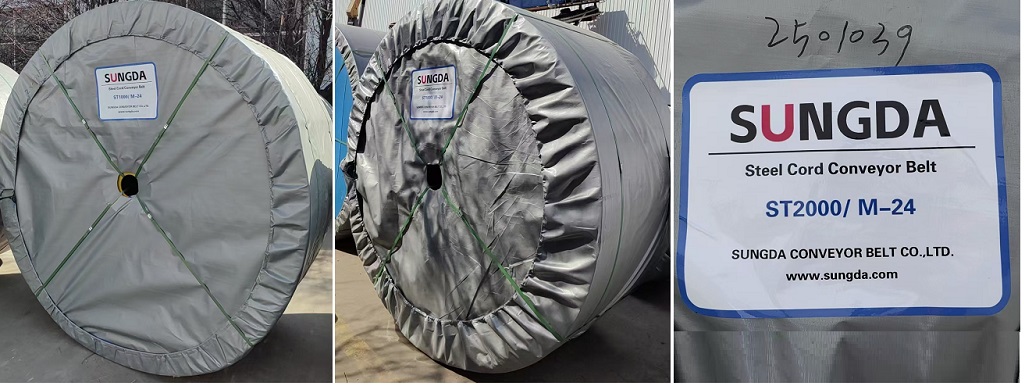
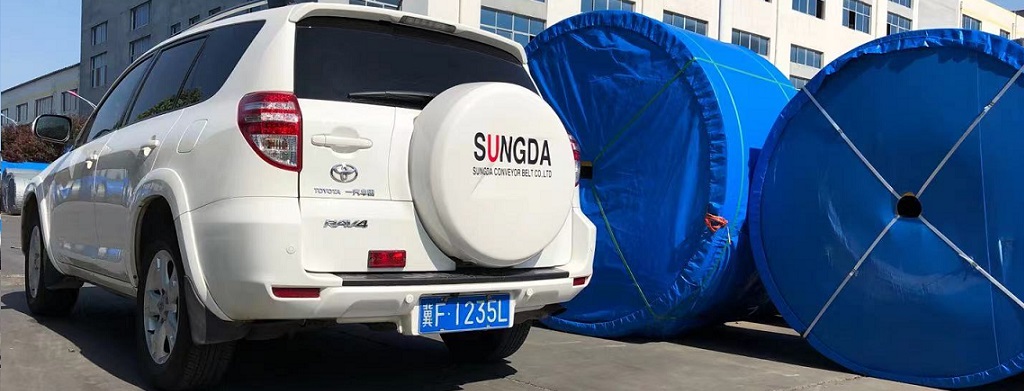

Tags: conveyor design,EP conveyor belt,Ep conveyor belt specification,FACTORY,manufacture,supplier

